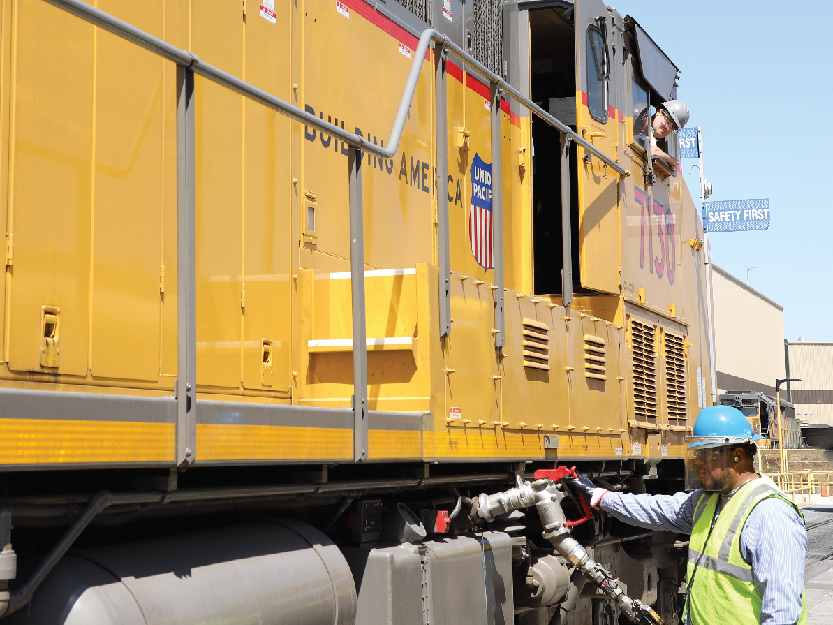Renewable Fuel Solutions for Railroads
The rail industry continues to advance lower carbon solutions to reduce lifecycle carbon emissions using bio-mass based diesel in locomotives.
Looking to 2030 and beyond, reducing fossil carbon emissions associated with rail transportation will continue to require fuel-efficient technologies, the increased use of lower carbon fuels and designing innovative lower emission supply chain solutions through investments and collaboration.
Chevron's lower carbon fuel solutions can help railroads lower lifecycle carbon emissions. In addition, these solutions can help the industry work toward lower carbon targets while offering engine performance benefits and reliable supply — typically all without any major infrastructure changes, making it a relatively easy transition.
Connect With a Railroad Expert
Connect with one of our experts for more information on pricing, availability, product information, logistics or if you have a general question.
Connect
How To Start Your Transition to Biodiesel and Renewable Diesel
When evaluating various lower carbon fuel solutions, your company should take a holistic approach and consider key factors such as technology readiness, operational impact, economic viability and fuel availability.
Biodiesel and renewable diesel check all those boxes — including usability in virtually any existing equipment, maintaining operations and being easily implemented and readily available.
Two key benefits of renewable fuel solutions include:
- the ability to use existing infrastructure, typically without additional investment
- maintaining interoperability that is critical to the operations of the railroad industry
As these fuels see increased adoption, lower carbon fuel producers such as Chevron continue to invest in enhancing the availability of these renewable fuels to market. One such example is the improvement and expansion of our Geismar biorefinery, which will increase production site capacity from 90 million gallons of renewable diesel production per year to 340 million gallons per year and helping Chevron achieve its stated target of 100,000 barrels per day by 2030.
Another relevant aspect is the availability of feedstocks that go into making lower carbon fuels. Chevron has a diversified strategy to source feedstocks reliably. Our feedstock flexibility helps ensure more predictable pricing, greater availability and lower carbon intensity.

Proven, Lower Carbon Fuels for Rail
Chevron's complete line of lower carbon fuel solutions can help you work toward your company’s lower carbon and profitability targets today.
Rail companies should consider using Biodiesel, Ultra Biodiesel and Renewable Diesel/Biodiesel Blend, all products of Chevron's Lower Carbon Fuel Solutions lineup.
Download Fact Sheet
Biodiesel and Renewable Diesel Can Help Reduce Lifecycle Carbon Emissions
Biodiesel blended with conventional diesel at varying levels has become fairly commonplace in the rail industry for nearly a decade, driven by its ability to be a drop-in solution.
Several key locomotive and engine manufacturers have already approved varying levels of biodiesel blends. Many OEMs approve the use of 100% renewable diesel (RD100) and blends of up to 20% biodiesel (B20) in their locomotive engines. These approvals have resulted in increased biodiesel utilization across rail networks to drive lifecycle carbon emissions reduction while also benefitting from incentives and market blend economics.
Q & A: Biodiesel and Renewable Diesel in the North American Rail Industry
Get insights on how biodiesel and renewable diesel play a role in helping to reduce lifecycle carbon emissions for locomotives.
Download Q & A
A Reliable, Lower Carbon Option
Railroads, national labs and OEMs are making significant progress with biofuels to gain confidence in performance aspects such as supply chain reliability, cold weather operability and transparency in handling under current infrastructure and operating procedures.
Why bio-mass based diesel from Chevron?
Simple, Lower Carbon Solution
- Carbon Intensity (CI) scores that are lower than petroleum diesel allow for reduced carbon intensity now
- Use as a drop-in fuel or as a blend with traditional fuels in virtually any existing engine infrastructure
Improved Performance and Excellent Quality
- Enhanced lubricity may help engines run smoother, cooler and quieter
- Lower particulate matter may help reduce DPF clogging and regenerations
- Stringent standards that exceed ASTM, CEN and CGSB quality requirements
- Biodiesel and renewable diesel can be a safer fuel in terms of combustibility and impact on the environment in the event of spillage3
Trusted and Proven Supply Partner
- Reliable production, supply, terminal infrastructure and logistics to be your partner
- International and domestic production footprint helps mitigate geopolitical risks of supply
- Feedstock flexibility provides added assurance of supply
- Our proprietary customer portal provides customers with online access to information regarding their accounts and deliveries, including invoices, BOLs and volumes.